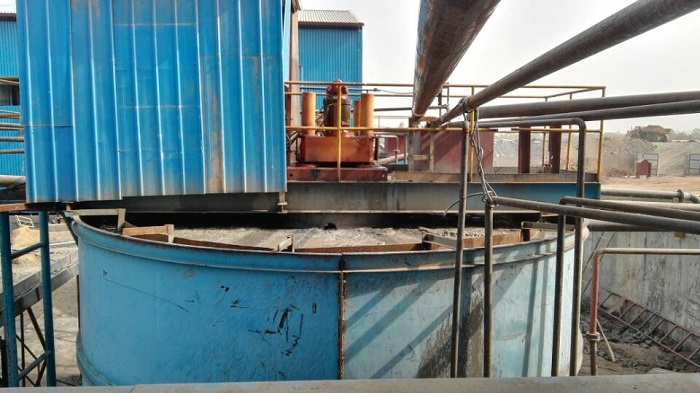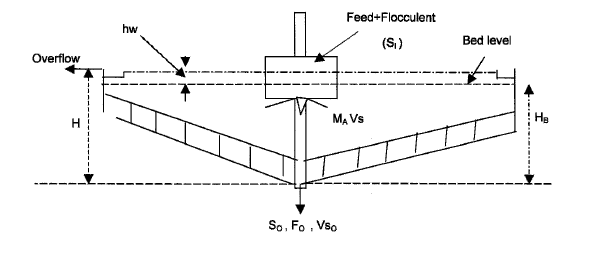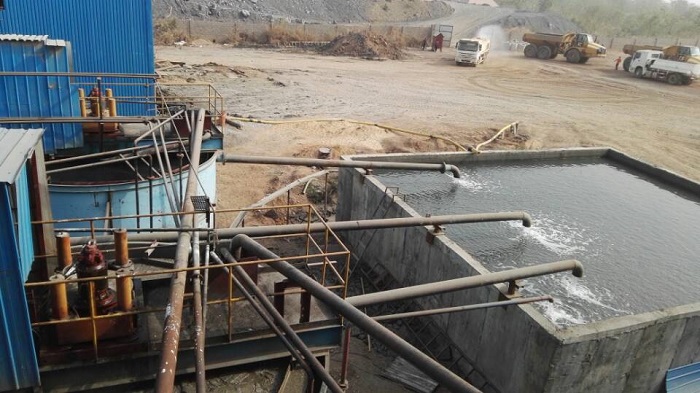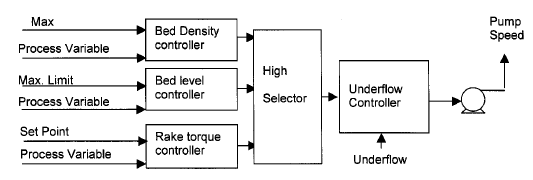The control of thickener operation is directed to obtaining a clear overflow as rapidly as possible. The sedimentation rate is usually accelerated by additions of flocculants.

Flocculants are added in the feed pipe (or feed launder) and maximum dispersion attempted by appropriate design of its entry to the thickener tank. The object is to entirely cover all the surface of mineral particles. The choice of flocculent and its concentration vary. It depends on the minerals present in the slurry, their composition and their surface characteristics. It is necessary not to have too much turbulence at the entry point of the tank.. For this purpose, the overflow level is kept sufficiently high above the feed level to ensure acceptable solid concentration in the overflow.
Fig. 1 is a schematic diagram of a thickener showing the different parameters. From a process control point of view the design parameters and major variables are:
1. height of the overflow clear fluid, H,
2. height of the bed level from discharge end, HB,
3. solids inventory, S,
4. sold mass inflow, Si,
5. solids mass outflow, So,
6. average bed solid volumetric fraction, vs

Fig1. Schematic diagram of thickener
The control of the solid contents in the overflow and underflow streams is the basis of thickener control. The average bed density (solids inventory) has to be controlled by the underflow flow rate and the flocculent additions to the slurry. To attain target overflow solids concentration the underflow density should be sufficiently high. This is obtained by longer residence time of treated slurry in thickener.
The underflow flow rate is measured by magnetic or ultrasonic flow meters.
The control scheme can now be summarized:
Level 1: Control loops
Two main loops are placed in Level 1. The first main loop (# 1) is for underflow control. The second main loop (#2) is for the control of flocculent flow.
At level #1, the essential process measurements for underflow control are:
1. rake torque with a torque meter fixed to the rakes,
2. bed level by using a simple float or vertical position sensor,
3. thickener bed pressure, by measuring the pulp pressure on the floor by a sensor.
At level #2 for flocculent loop control, measurements are chiefly flow rates of fluids by standard flow meters and power draft measurements for variable speed positive displacement pump. Other measurements at this level include:
1. pump speed,
2. underflow density measurement (y-ray density gauge),
3. pump discharge pressure by standard pressure gauge.

Level 2: Control loops
The aim of Level 2 is to keep the underflow bed level close to target. The set point of the bed level is therefore controlled by the bed level controller. In practice it is found that the bed level can be disturbed by high bed density which could result in high torque on the rakes. To avoid such situations the basic flow control is designed to be over-ridden. This is achieved by providing a high-selector that outputs the flow set point. Such an arrangement is shown in Fig. 2 where it can be seen that the bed density and rake torque with maximum limiting values are connected to the high selector. The output from high selector or the flow controller set point has a set low limit. A safe flow is therefore maintained from the underflow. The pump that pumps the underflow is set to high and low speed limits taking signals from the output of the flow controller The advantage of this system is that in the event the thickener operation ceases due to say, stoppage of mill operation, and therefore feed to the thickener, the underflow pump continues to operate till the thickener is empty and chances of clogging is remote.

Fig.2. Underflow control setup
The pump speed controller incorporates limiting power draft so that the pump does not trip at high power.
For controlling the flocculent flow signals are taken from the bed density controller. Controlling the flocculent flow is difficult by this method as it takes time for the flocculent to properly mix with the rest of the inventory. The speed of response varies with the rate of change of bed density.
Level 3: Control loops
Level 3 control involves optimisation of thickener operation (and pipe lines). This includes cost function based on:
1. flocculent consumption,
2. pump power,
3. discharges to tailings.
All these factors depend on the underflow density set point. Optimum conditions are usually ascertained by trial and error method by taking signals from the underflow density, pump discharge pressures and pump power drafts and estimating the corresponding cost functions.